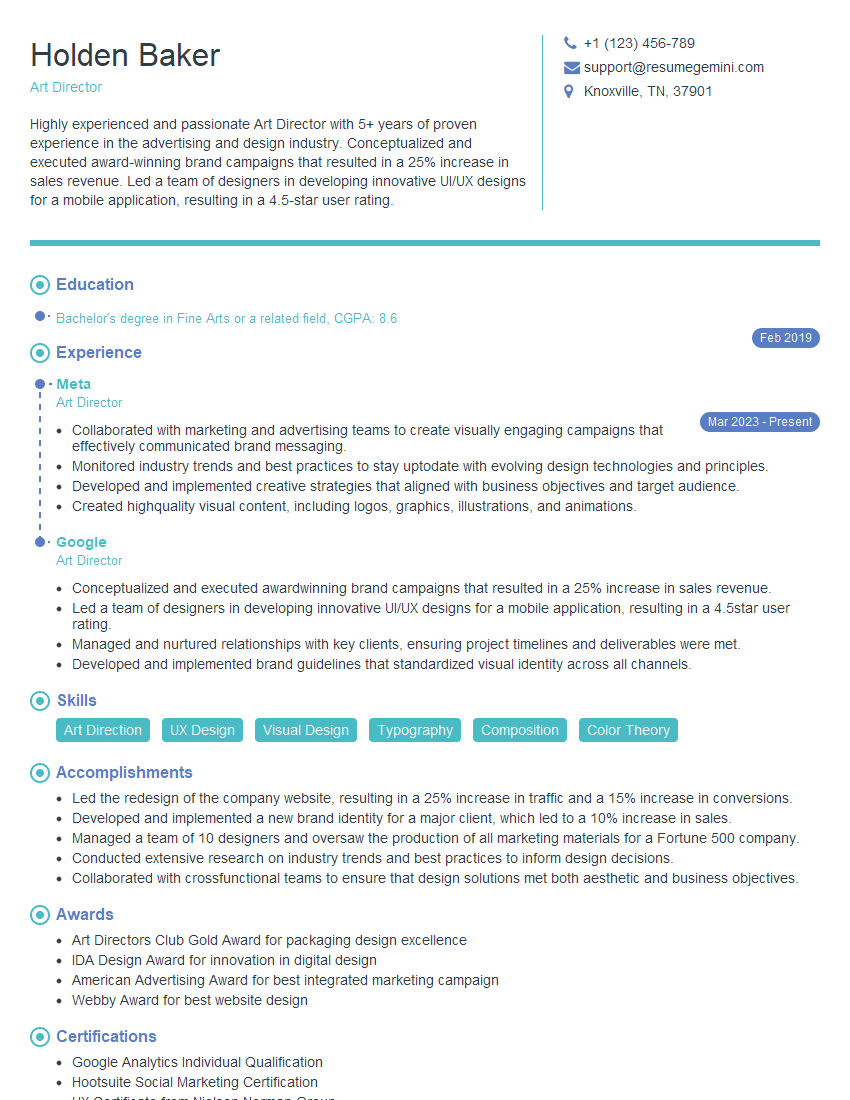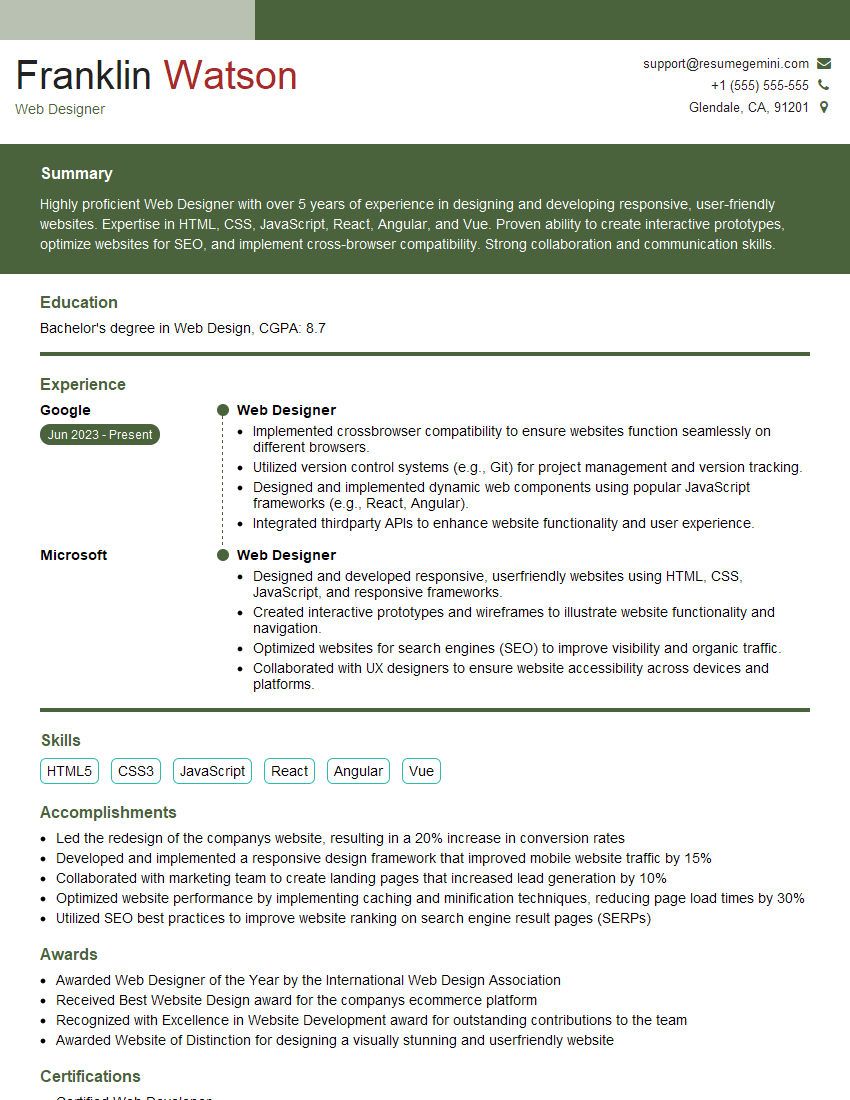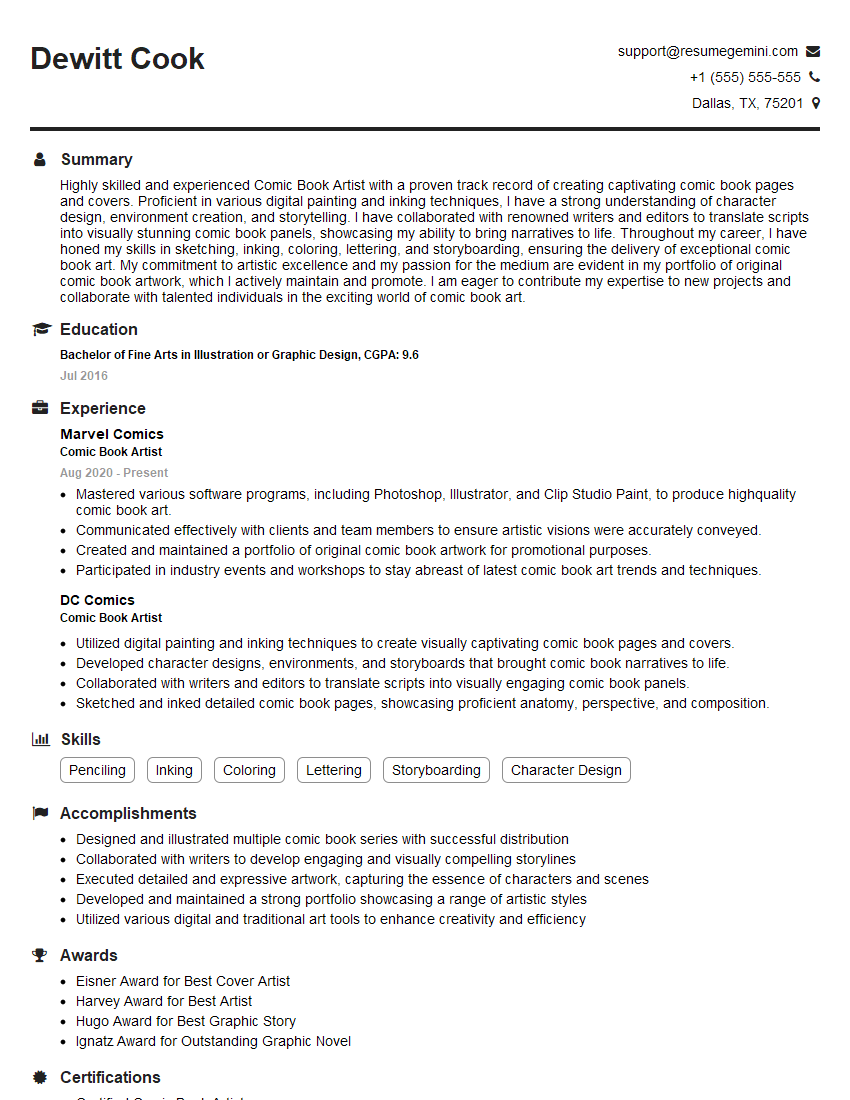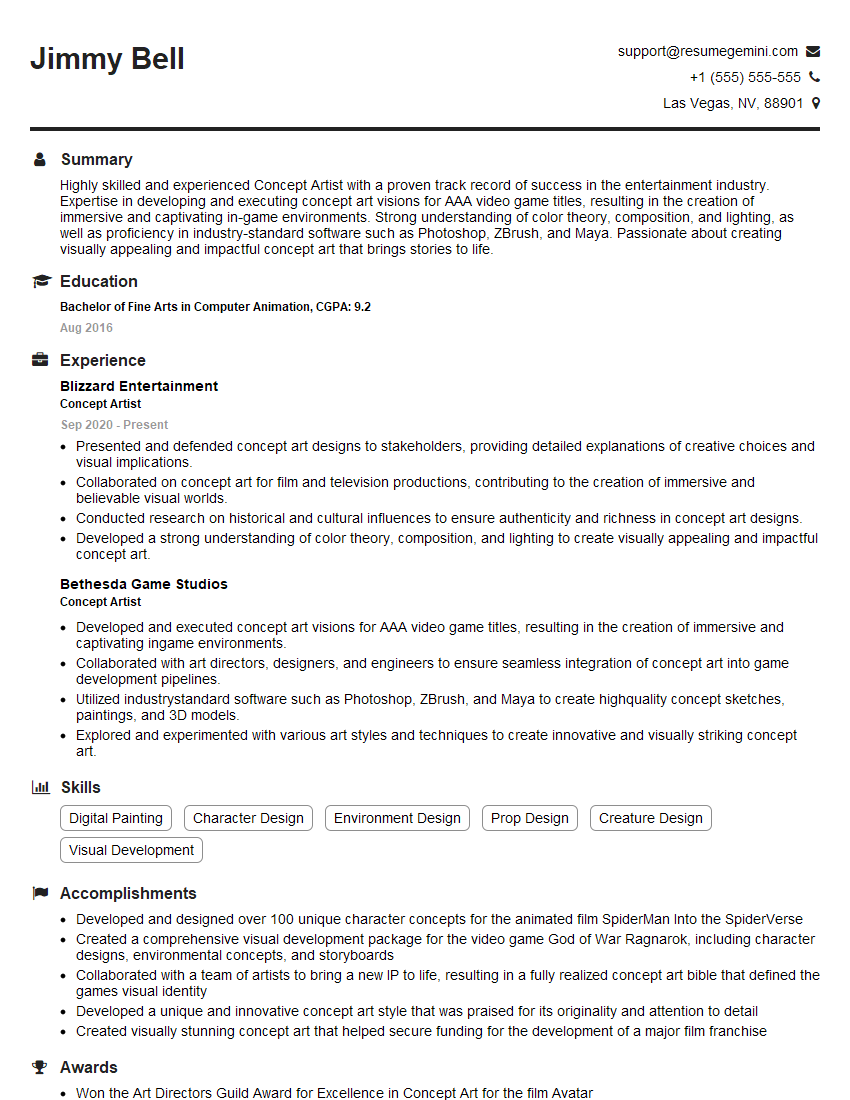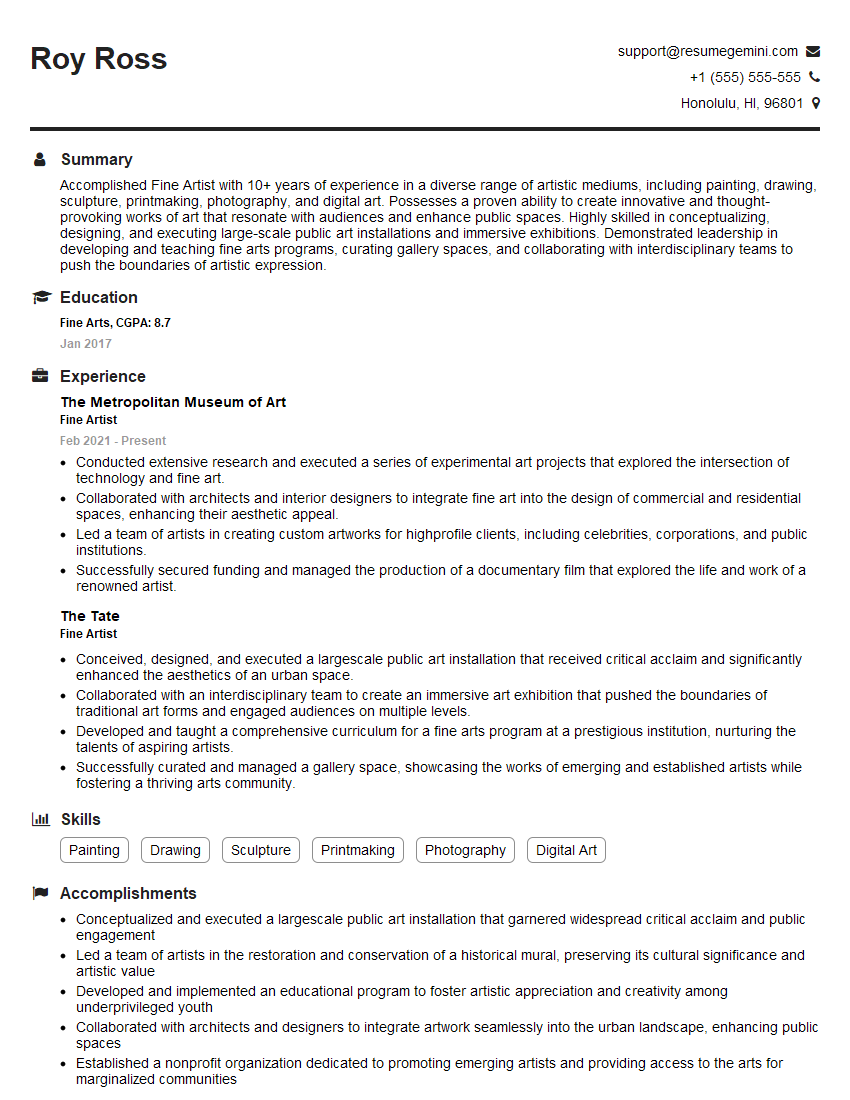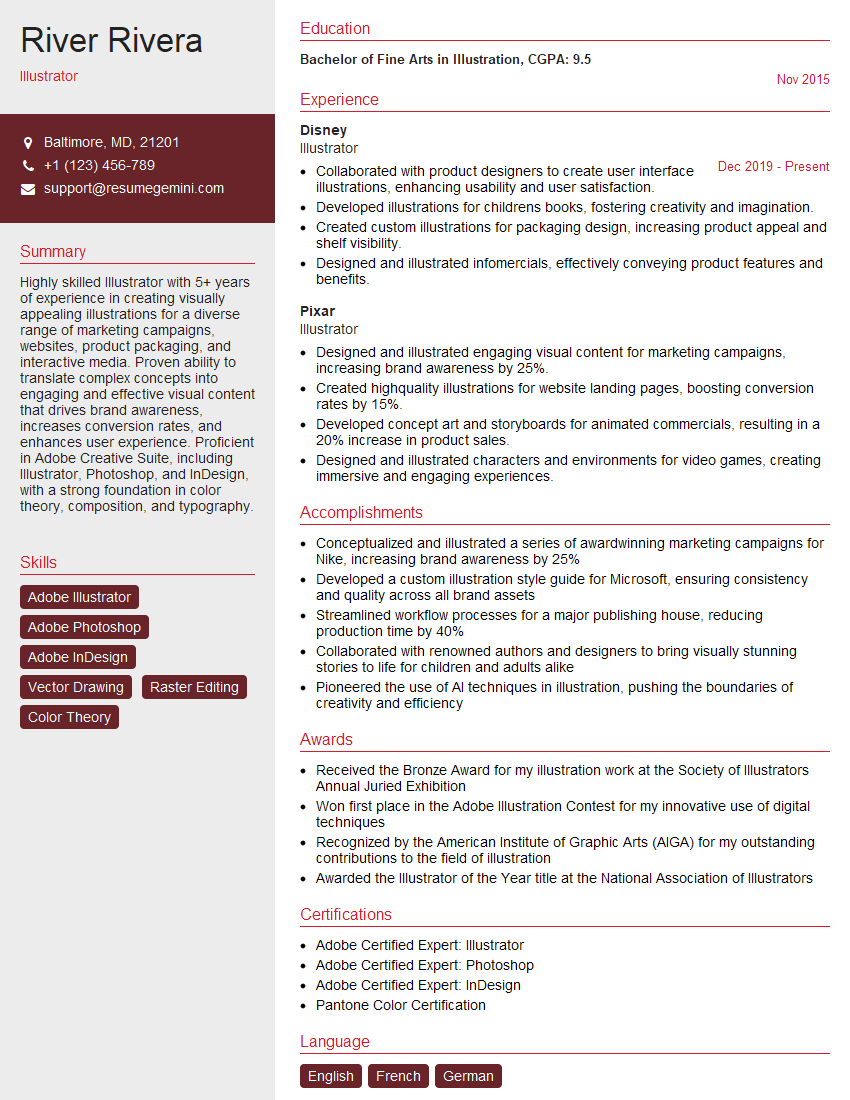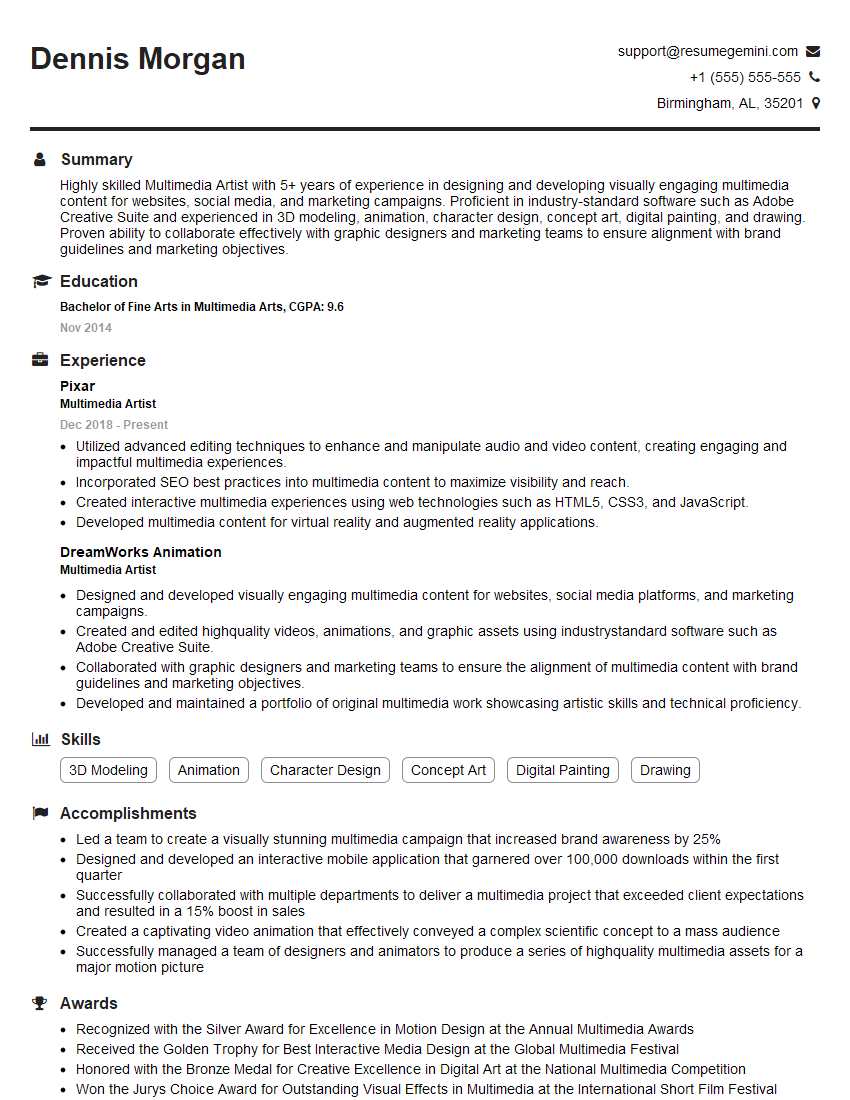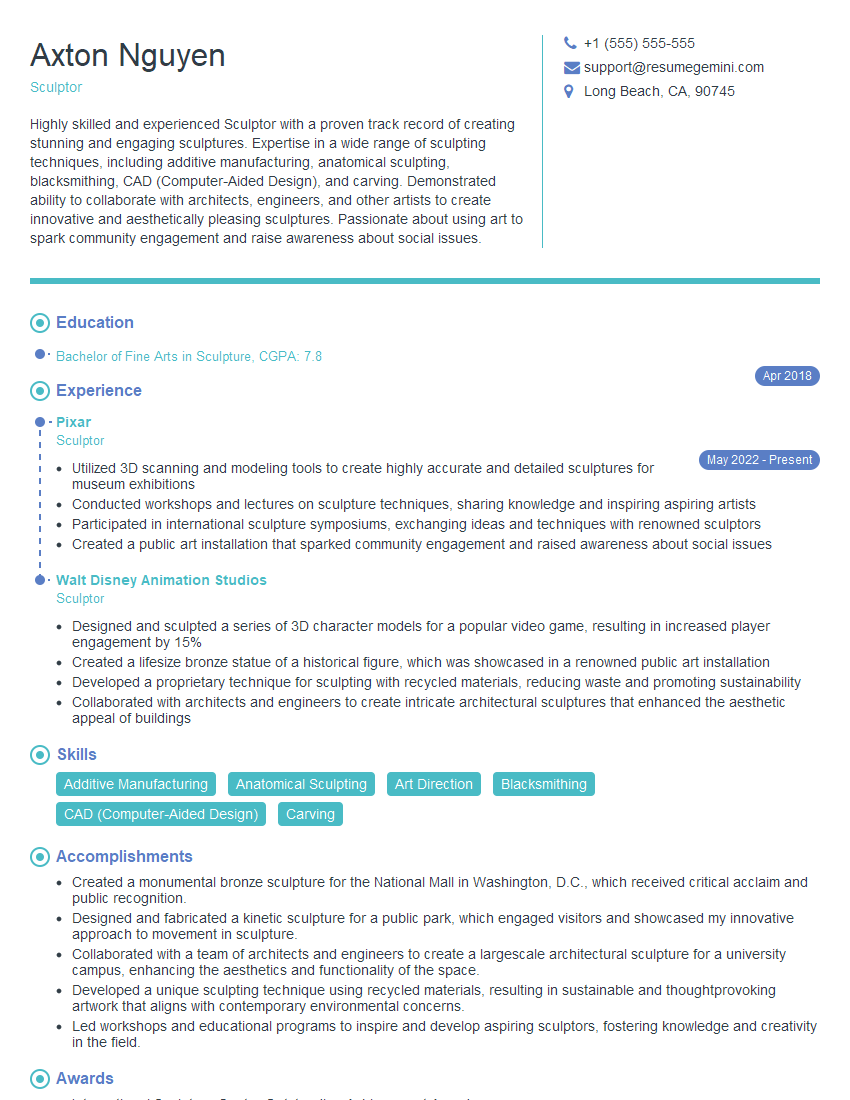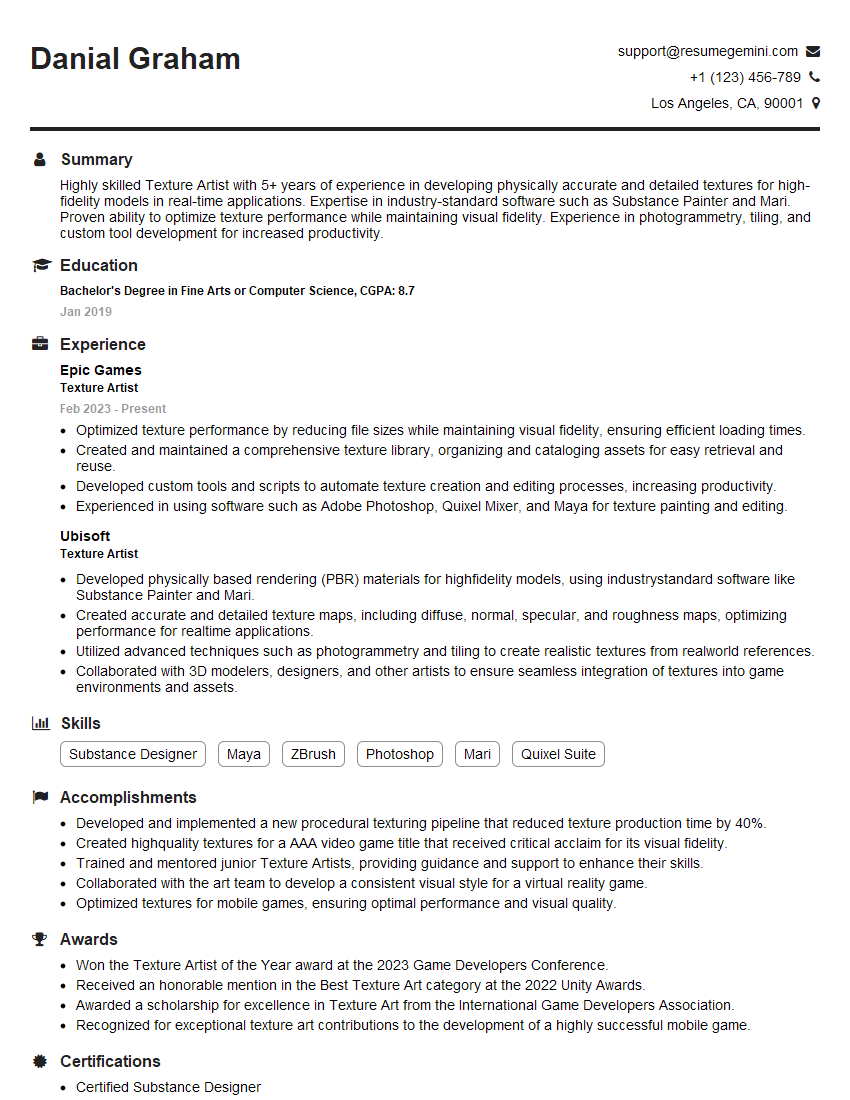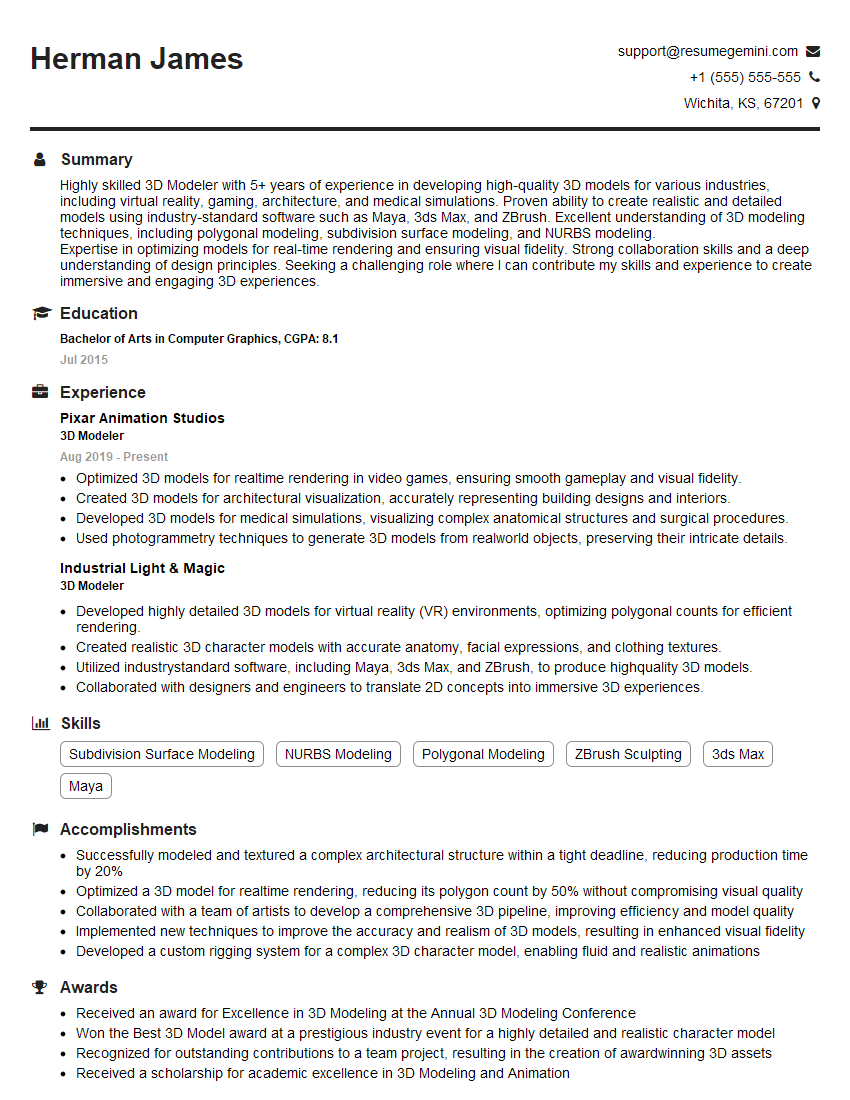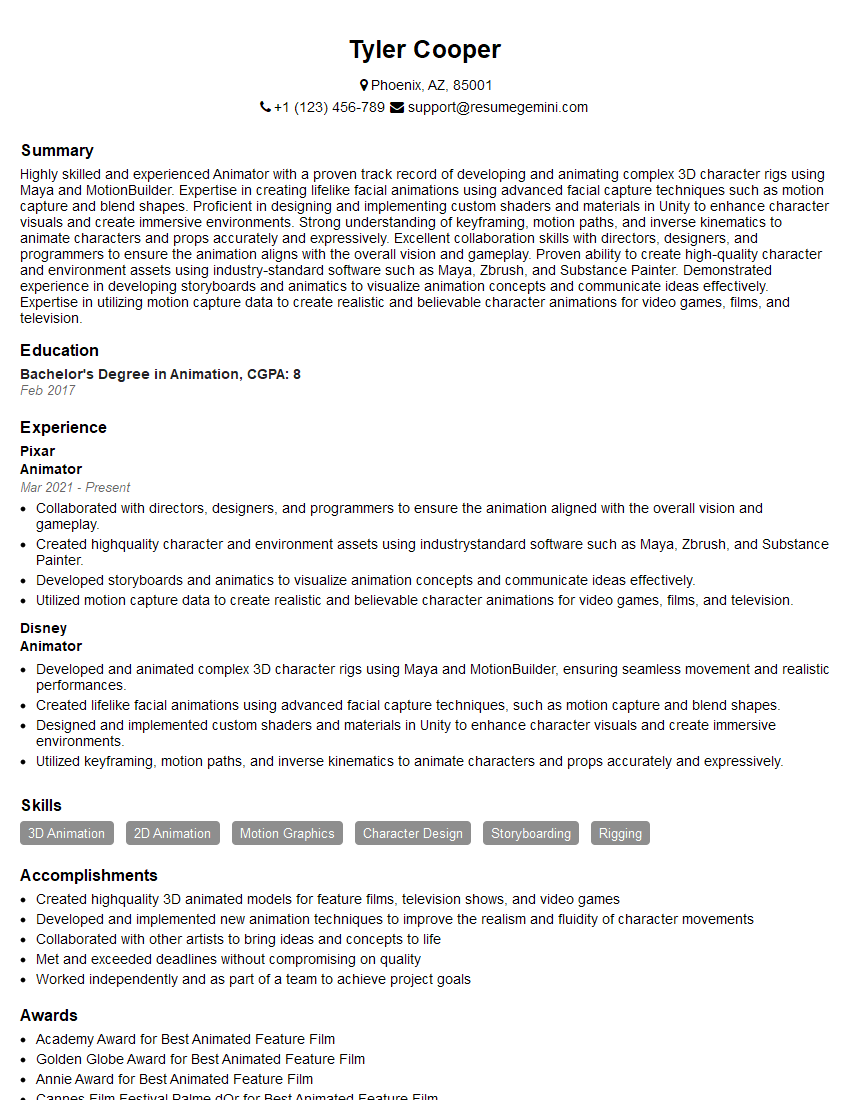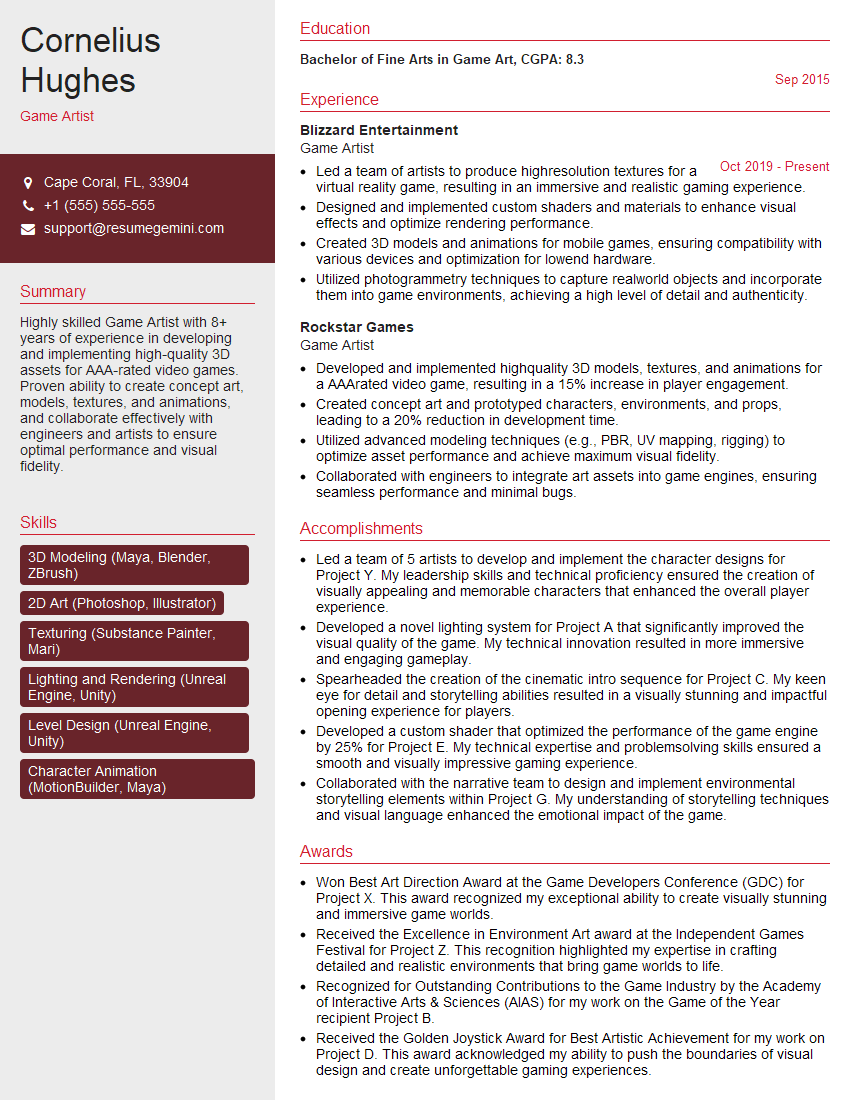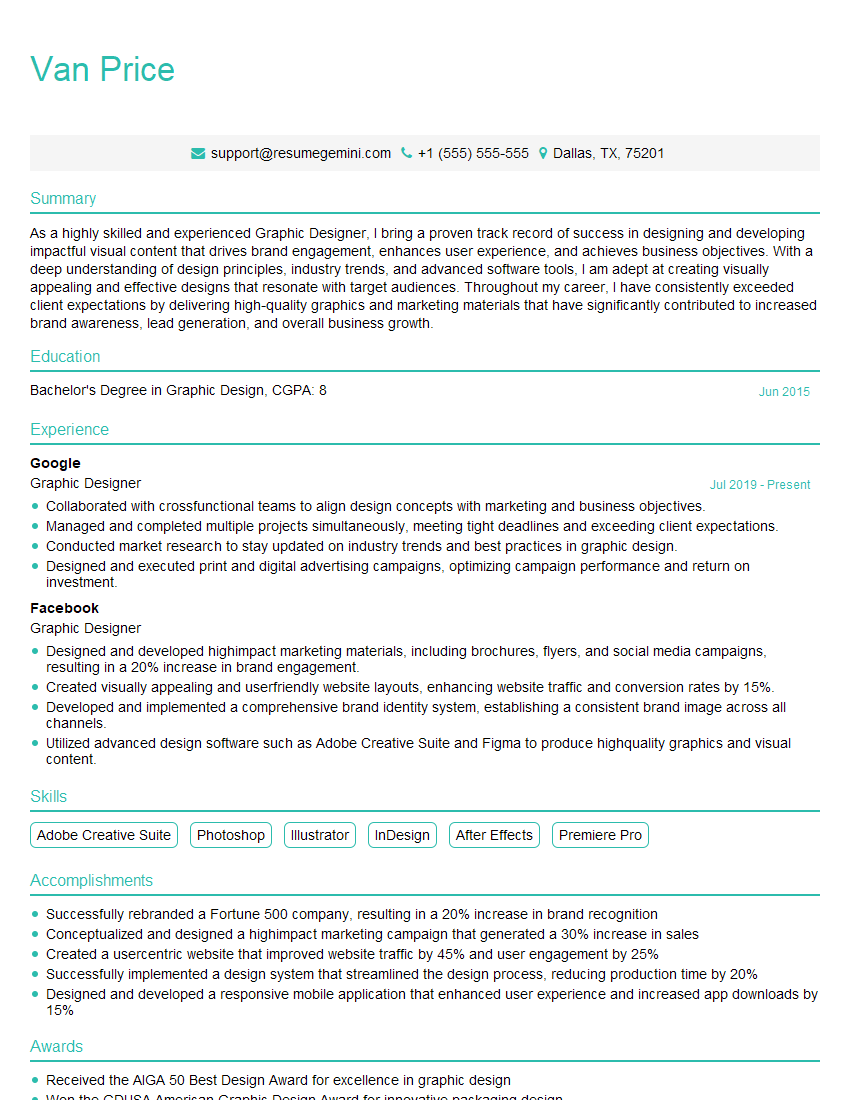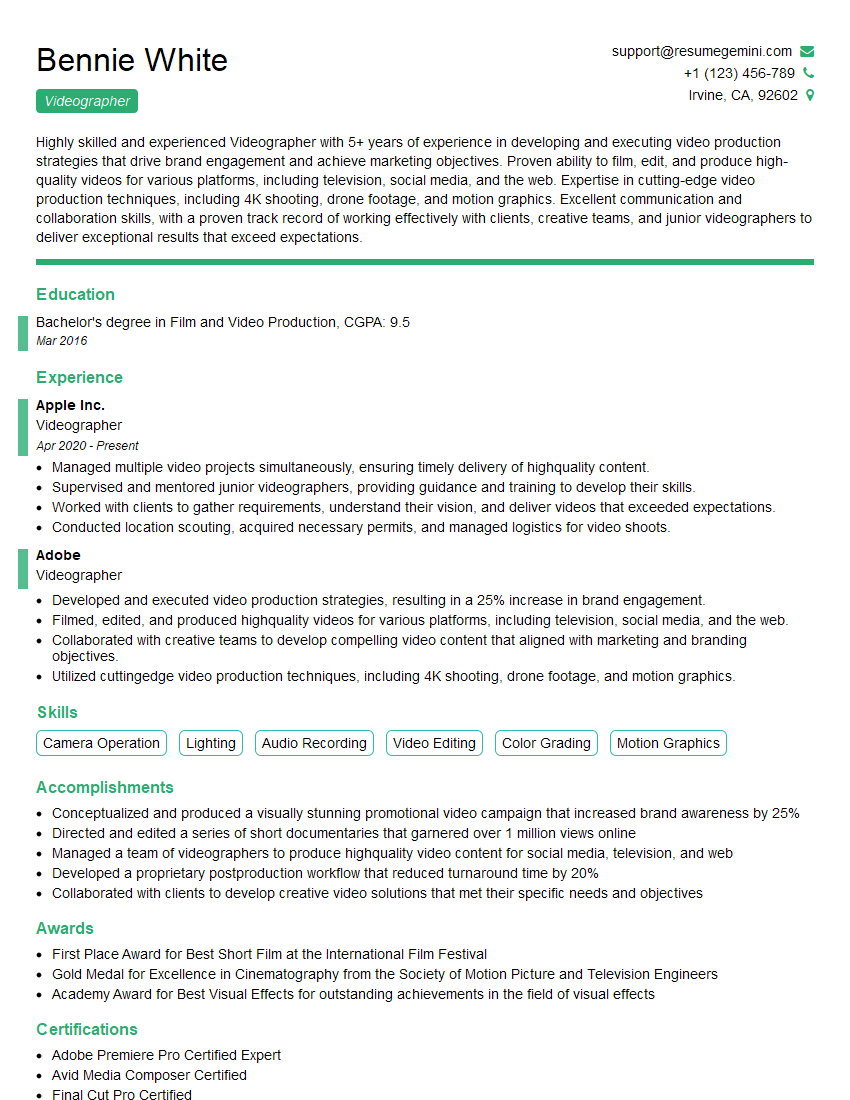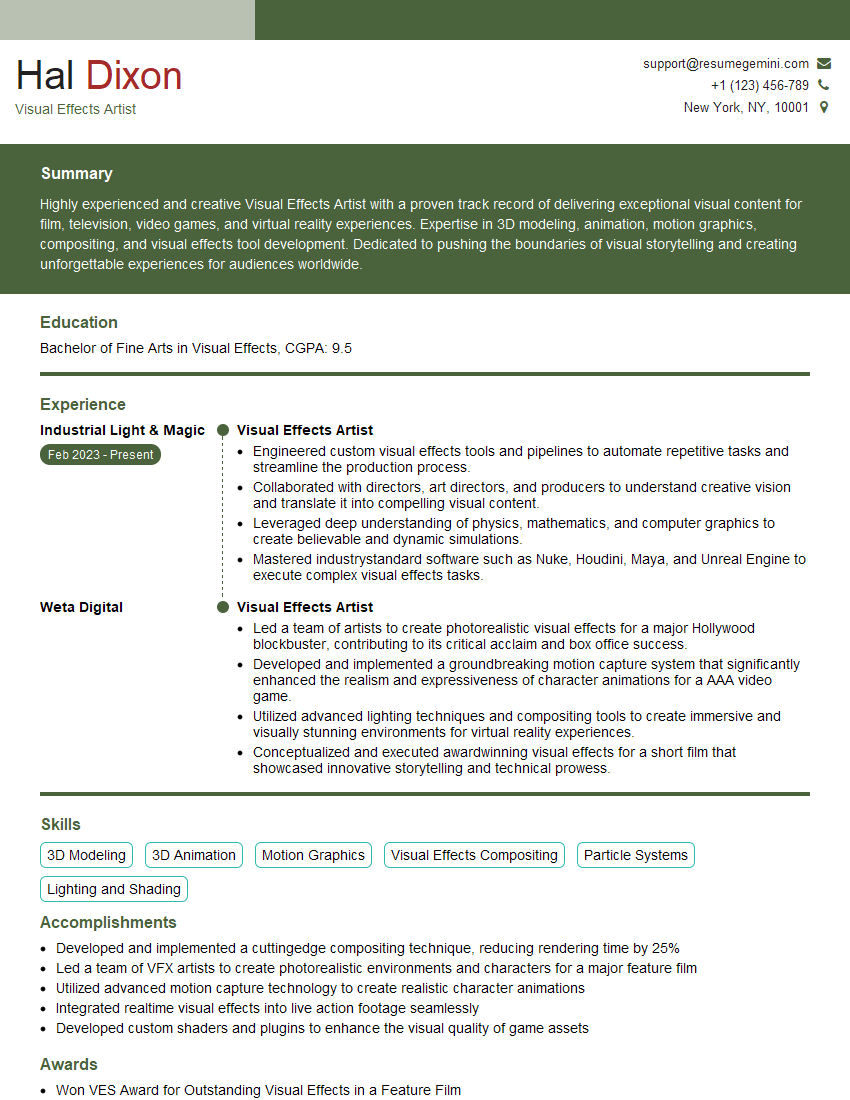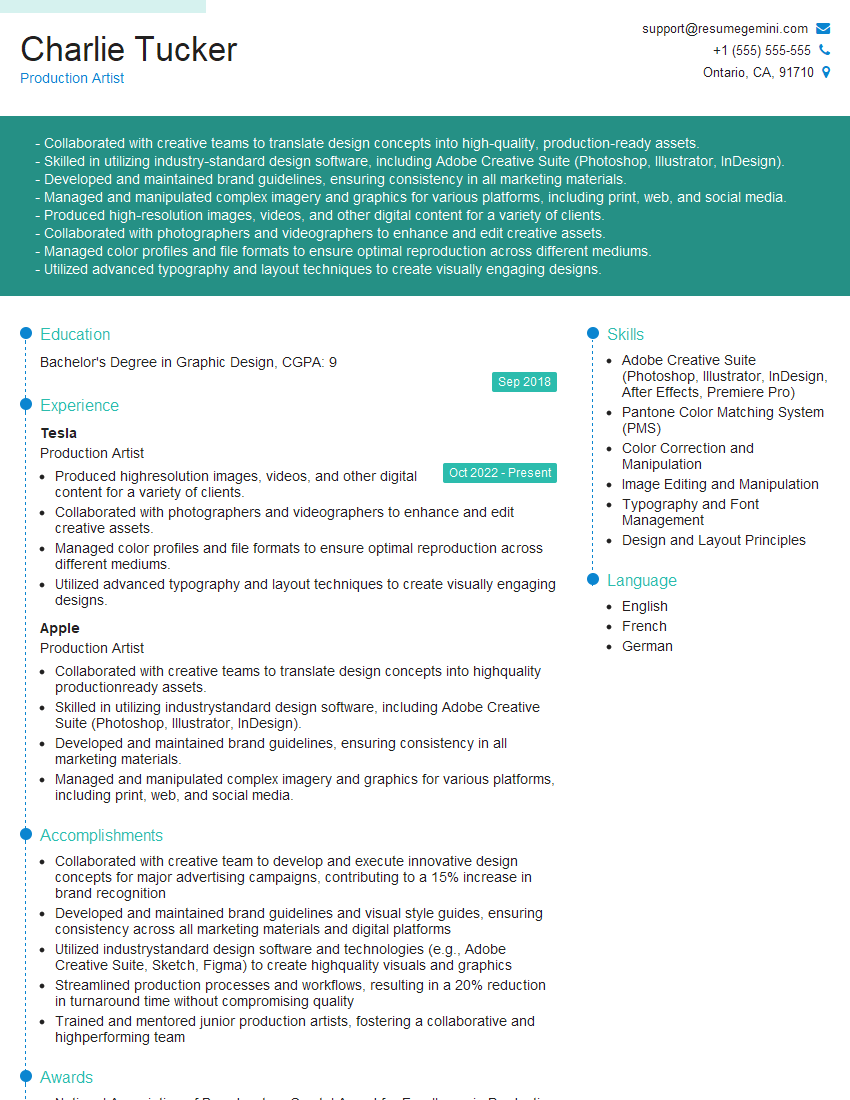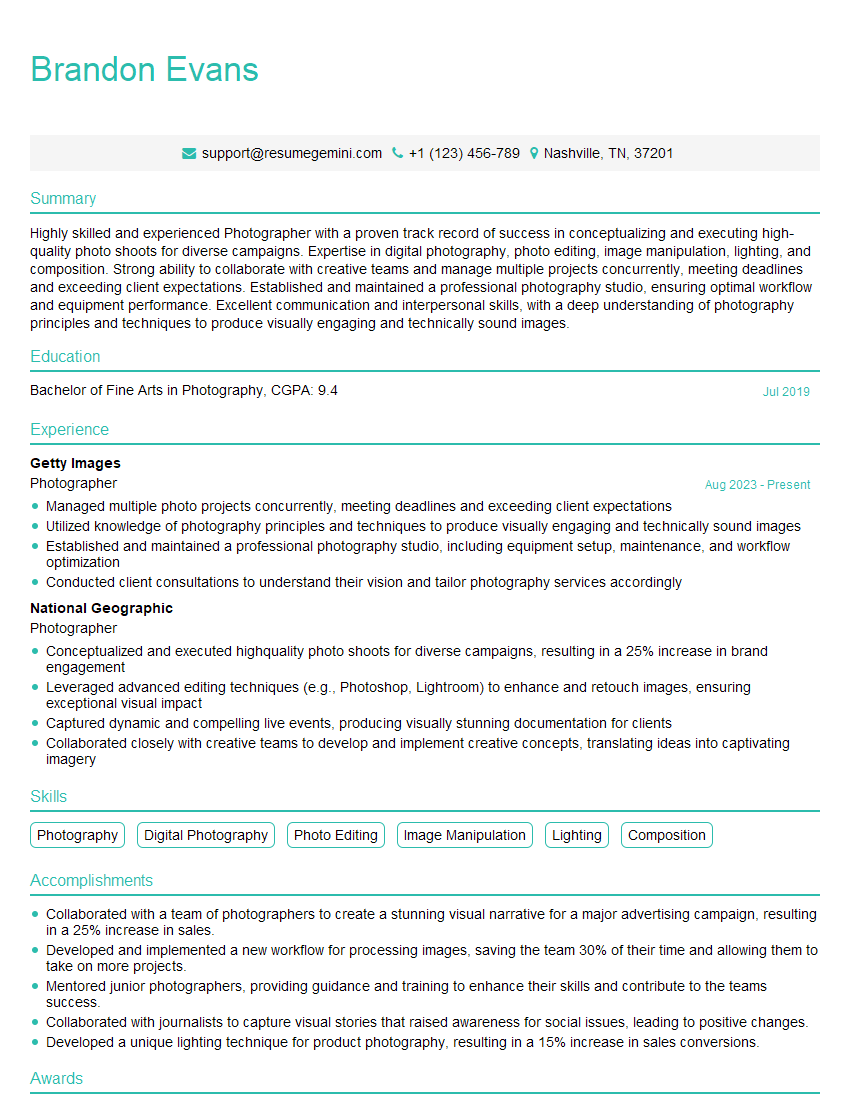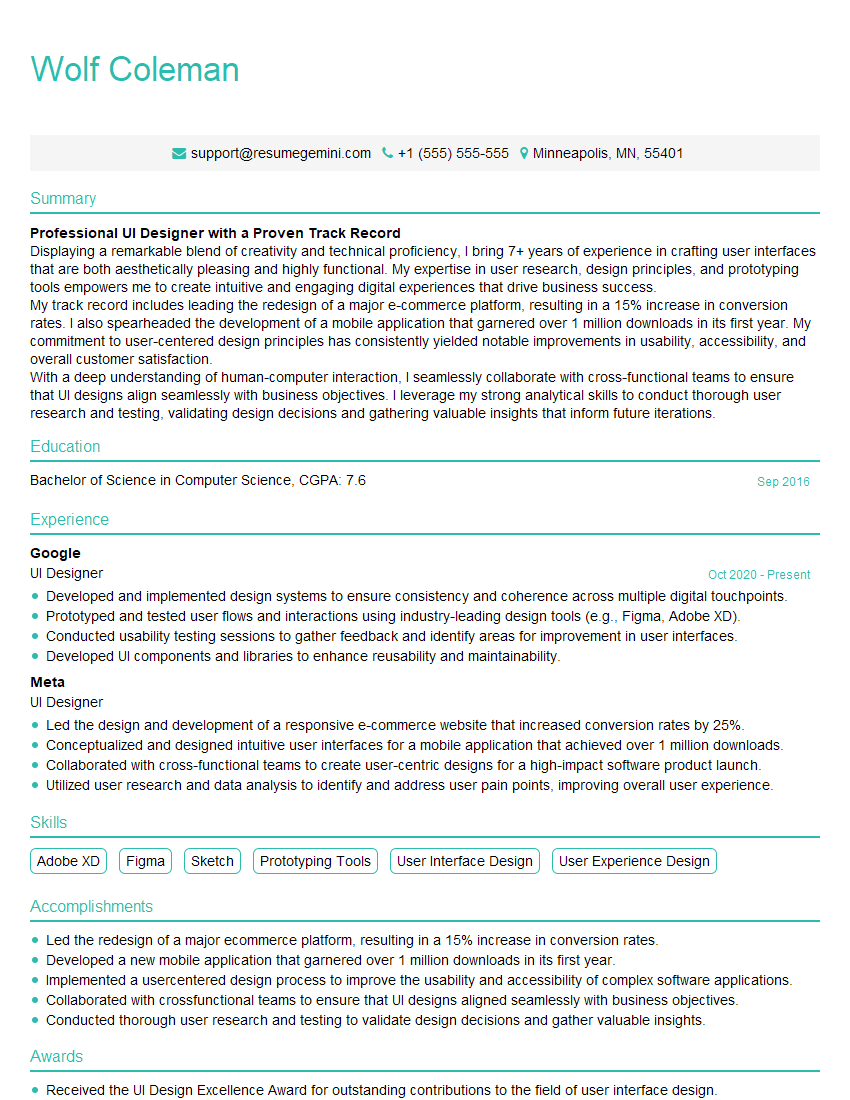Preparation is the key to success in any interview. In this post, we’ll explore crucial Artistic Talent interview questions and equip you with strategies to craft impactful answers. Whether you’re a beginner or a pro, these tips will elevate your preparation.
Questions Asked in Artistic Talent Interview
Q 1. Describe your artistic process from concept to completion.
My artistic process is iterative and deeply rooted in exploration. It begins with a concept, often sparked by a feeling, an image, or a compelling narrative. I spend considerable time brainstorming and sketching, developing thumbnails to explore different compositional possibilities and refine my initial vision. This phase is crucial for problem-solving potential challenges before committing to a final piece. Next comes the detailed sketching phase where I solidify the composition, refine the forms, and pay close attention to anatomical accuracy (if applicable). This is followed by the execution phase, where I translate my sketch into the chosen medium. I work in layers, continually assessing and refining my work as I progress. The final stage involves reviewing and editing; this might include tweaking details, adjusting values, or making final color corrections before calling the piece complete. For example, in a recent portrait commission, I went through five different thumbnail sketches before settling on a three-quarter view that best captured the subject’s personality. This iterative approach allows me to experiment freely, making adjustments along the way.
Q 2. Explain your preferred artistic medium and why.
My preferred artistic medium is digital painting, primarily using Photoshop. I chose this medium for its versatility and flexibility. It allows for a level of control and precision that’s difficult to achieve with traditional mediums. The ability to undo mistakes, experiment with layers, and easily manipulate colors and textures is invaluable. For instance, I can seamlessly blend realistic textures with painterly brushstrokes, or easily adjust lighting and color palettes throughout the process. The non-destructive nature of digital painting means I can revisit and refine my work long after the initial creation, making it an ideal environment for iterative refinement. While I appreciate the tactile qualities of traditional mediums, the efficiency and capabilities of digital painting best suit my workflow and artistic vision.
Q 3. How do you handle constructive criticism of your work?
I view constructive criticism as an invaluable tool for growth. I actively seek feedback from trusted peers and mentors, and I approach it with an open mind. I listen carefully, trying to understand the critic’s perspective and identify areas for improvement. I don’t take criticism personally; instead, I focus on the objective observations about the artwork itself. For instance, if a critique points to a weak composition, I analyze the feedback, looking for ways to restructure or adjust elements to strengthen it. I document the feedback I receive, along with my own thoughts and reflections, creating a valuable record of my artistic journey and development. This approach has consistently helped me improve my technical skills, refine my artistic vision, and ultimately, create stronger, more impactful artwork.
Q 4. What software and tools are you proficient in?
I’m proficient in Adobe Photoshop, Adobe Illustrator, and Clip Studio Paint. My skills encompass digital painting, illustration, photo manipulation, vector graphics, and 3D rendering (basic). In Photoshop, I’m highly skilled in using adjustment layers, blending modes, and various brushes to achieve specific artistic effects. In Illustrator, I’m comfortable creating vector artwork for logos and illustrations. Clip Studio Paint is my go-to for creating detailed line art and comics. I’m also familiar with various 3D modeling software for creating basic models and incorporating them into my compositions. These programs, combined with a Wacom Cintiq tablet, enable me to bring my artistic visions to life with precision and efficiency.
Q 5. Showcase a project where you overcame a significant artistic challenge.
One project that presented a significant challenge was a large-scale mural commission depicting a bustling cityscape at night. The challenge lay in balancing the complexity of the scene with the need for a cohesive composition and realistic lighting. The sheer scale of the piece and the minute details required were daunting. To overcome this, I utilized a modular approach, breaking the cityscape into smaller, manageable sections which I individually painted and then assembled in Photoshop. This allowed me to meticulously manage detail without feeling overwhelmed by the overall complexity. I also used advanced lighting techniques like ambient occlusion and color grading to achieve realistic night lighting and to unify the different elements of the piece into a visually coherent whole. The final result was a successful mural that impressed the client and significantly boosted my confidence in tackling ambitious projects.
Q 6. Describe your understanding of color theory and its application.
My understanding of color theory is foundational to my artistic process. I understand the color wheel, complementary colors, analogous colors, and triadic harmonies. I leverage this knowledge to create mood, emphasize focal points, and convey emotion. For example, warm colors like reds and oranges can create a sense of energy and excitement, while cool colors like blues and greens evoke calmness and tranquility. I also understand the principles of value and saturation, using these to create depth and visual interest. Mastering color temperature is crucial for realism. I frequently utilize color studies to explore a variety of color palettes before committing to a final scheme. This systematic approach to color choice elevates my work from technically proficient to artistically impactful.
Q 7. How do you stay current with industry trends and new technologies?
Staying current involves a multi-pronged approach. I actively follow prominent artists and designers on social media platforms like Instagram and ArtStation for inspiration and exposure to new styles and techniques. I attend online workshops and webinars, and actively participate in online art communities to engage with discussions and learn from other professionals. I subscribe to art-related magazines and newsletters, keeping me up-to-date with technological advancements in software and hardware. I also dedicate time to experimenting with new software and tools. This combination of formal and informal learning ensures I remain at the forefront of industry trends and technological innovations, continually enhancing my skills and artistic approach.
Q 8. Explain your approach to collaborating with other artists or designers.
Collaboration is the cornerstone of successful artistic projects. My approach centers around open communication, mutual respect, and a shared vision. I believe in active listening to understand the other artists’ perspectives and ideas, fostering a collaborative environment where everyone feels valued and empowered to contribute their unique talents.
Before embarking on a project, I initiate a thorough discussion to clarify individual roles, responsibilities, and creative goals. This ensures that everyone is on the same page, minimizing misunderstandings and conflicts down the line. I utilize various communication tools, including regular check-ins, shared online workspaces, and constructive feedback sessions, to maintain seamless communication throughout the project lifecycle.
For example, in a recent mural project, I collaborated with a sculptor and a graphic designer. We held initial meetings to discuss the overall concept, color palettes, and material choices. We then divided the work into manageable segments—the sculptor focused on the three-dimensional elements, the graphic designer handled the digital components, and I integrated both into the final painted mural. Regular meetings ensured we stayed aligned and that each element complemented the others.
Q 9. How do you manage your time and prioritize tasks effectively?
Time management is crucial for an artist. My strategy relies on a blend of planning, prioritization, and self-discipline. I start by creating a detailed project schedule, breaking down large tasks into smaller, manageable steps. This allows me to track my progress effectively and identify potential bottlenecks early on.
I utilize a combination of digital and physical tools. I use project management software to schedule deadlines, assign tasks, and monitor progress. Simultaneously, I maintain a physical sketchbook and calendar to jot down ideas, inspiration, and daily tasks. This hybrid approach helps me maintain a clear overview and stay organized. I prioritize tasks based on their urgency and importance, focusing on high-impact activities first. I also incorporate regular breaks and time for unexpected events or creative exploration into my schedule to avoid burnout and maintain a healthy work-life balance.
For instance, when working on a tight deadline for a client, I prioritize the core elements of the project first, ensuring they meet the client’s critical needs. Once these are completed, I can move on to the less time-sensitive details. This approach guarantees that the project’s essential components are delivered on time and to the required standard.
Q 10. Describe your experience with different design styles (e.g., minimalist, surrealist).
My artistic journey has encompassed a wide range of design styles. I’m proficient in minimalist design, appreciating its clean lines, simplicity, and focus on essential elements. I’ve successfully created minimalist logos, websites, and illustrations, prioritizing functionality and visual clarity. On the other hand, I’m equally fascinated by surrealism, using it to explore dreamlike imagery, unexpected juxtapositions, and symbolic representations. This allows me to express unconventional ideas and emotions through art.
Minimalism, for me, is about communicating a powerful message with the least amount of visual information—think of the iconic Apple logo. Surrealism, conversely, is about creating a visual narrative that pushes boundaries and invites interpretation—consider the works of Salvador Dalí. My ability to comfortably navigate these diverse styles allows me to adapt my approach to any client’s specific needs and aesthetic preferences.
In practice, I might use minimalist techniques for a corporate logo, where simplicity and memorability are paramount, and draw on surrealist elements to illustrate a children’s book, where fantasy and imagination are key ingredients.
Q 11. How do you ensure your work meets the client’s brief and expectations?
Meeting client expectations is paramount. My process starts with a thorough understanding of the brief. This includes not just the stated requirements but also the underlying goals, target audience, and desired impact. I actively engage in discussions with clients to clarify ambiguities and ensure a shared understanding of the project’s vision. I present mood boards, sketches, and prototypes at various stages to receive feedback and adjust the direction accordingly.
Throughout the project, I maintain open and transparent communication. I provide regular updates on progress, highlighting any potential challenges or changes early on, enabling proactive adjustments. Before final delivery, I conduct a comprehensive review, ensuring that the final artwork aligns perfectly with the brief and surpasses client expectations. This iterative feedback loop ensures that the final product accurately reflects the client’s vision and needs.
For example, in one project, the client initially envisioned a vibrant and colorful design. Through discussions, we discovered that the target audience preferred a more subtle and sophisticated aesthetic. By adapting the design accordingly, we delivered a final product that resonated with the target market and exceeded the client’s expectations.
Q 12. What is your approach to problem-solving in a creative context?
Problem-solving in a creative context often involves unconventional approaches. My approach involves a multi-stage process. First, I thoroughly analyze the problem, identifying the root cause and defining the desired outcome. Then, I brainstorm potential solutions, exploring diverse perspectives and approaches. This often involves sketching, experimenting with different mediums, and seeking inspiration from unrelated fields. Next, I evaluate the feasibility and effectiveness of each solution, considering factors such as time constraints, resources, and aesthetic coherence. Finally, I select the most viable solution and refine it iteratively, incorporating feedback and making necessary adjustments until the desired outcome is achieved.
Imagine facing the challenge of designing a logo for a tech startup that needs to convey both innovation and trustworthiness. I might initially sketch several different concepts, experimenting with different fonts, colors, and symbolic elements. I’d then present these to the client, soliciting feedback to fine-tune the design. This iterative process helps to refine the logo until it perfectly embodies the client’s vision.
Q 13. Explain your understanding of visual hierarchy and its importance in design.
Visual hierarchy is the arrangement of elements in a design to guide the viewer’s eye and communicate information effectively. It determines the order in which the viewer perceives visual information. Elements with higher visual weight, like size, color, or contrast, are perceived first, establishing a clear path for the viewer’s eyes. Understanding and effectively implementing visual hierarchy is crucial for creating designs that are both aesthetically pleasing and easily understandable.
Consider a website. The most important information, like the headline or call to action, would be given higher visual weight—larger font size, bold colors, strategic placement. Less crucial information, such as copyright details, would be smaller and less prominent. Without visual hierarchy, the viewer would be overwhelmed by a jumble of information with no clear focal point. Mastering visual hierarchy results in visually appealing, understandable, and effective designs, ensuring that the viewer’s attention is directed in the most effective way.
Q 14. Describe a time you had to adapt your artistic style to a specific project.
I was once commissioned to create a series of illustrations for a children’s book about ancient Egypt. My typical style leans towards a more abstract and modern aesthetic. However, this project required a more realistic and historically accurate representation. I adapted my style by extensively researching Egyptian art, architecture, and culture, studying the colors, patterns, and artistic conventions of the period.
Initially, I struggled to shift from my usual style, but I embraced the challenge as an opportunity to expand my skillset. I incorporated elements of traditional Egyptian art, such as hieroglyphs and symbolic imagery, while maintaining a level of visual clarity suitable for a children’s audience. The final illustrations received positive feedback, demonstrating my ability to adapt my artistic style while maintaining a high level of craftsmanship and visual appeal. This experience highlighted the importance of adaptability and research in artistic endeavors.
Q 15. How do you balance creativity with technical execution?
Balancing creativity and technical execution is a constant dance for any artist. It’s about finding the sweet spot where your artistic vision is flawlessly realized through skilled technique. Think of it like a chef with a brilliant recipe (creativity): the dish won’t be successful without the proper cooking skills (technical execution) to bring it to life.
I approach this by meticulously planning my work. Before I even pick up a brush or start a digital painting, I’ll sketch out concepts, explore color palettes, and consider the technical aspects like brushstrokes, line weight, or the resolution of my digital canvas. This planning stage allows me to refine my creative ideas while simultaneously ensuring they’re technically feasible. For example, if I’m working on a highly detailed realistic portrait, I’ll invest time in understanding the nuances of light and shadow and the technical skills needed to render them convincingly, rather than just focusing on the emotional expression in the subject’s eyes.
During the execution phase, I’m constantly checking if my creative vision aligns with the technical reality. I might adjust my technique based on the materials I use. Perhaps a certain paint requires a different approach to achieve the desired texture, or a specific digital tool necessitates an adjustment in my workflow. This iterative process ensures a harmonious balance between my creative intent and its successful technical rendering.
Career Expert Tips:
- Ace those interviews! Prepare effectively by reviewing the Top 50 Most Common Interview Questions on ResumeGemini.
- Navigate your job search with confidence! Explore a wide range of Career Tips on ResumeGemini. Learn about common challenges and recommendations to overcome them.
- Craft the perfect resume! Master the Art of Resume Writing with ResumeGemini’s guide. Showcase your unique qualifications and achievements effectively.
- Don’t miss out on holiday savings! Build your dream resume with ResumeGemini’s ATS optimized templates.
Q 16. What are your strengths and weaknesses as an artist?
My greatest strength lies in my conceptual thinking and ability to develop strong visual narratives. I excel at crafting compelling stories and moods through my art. I’m also highly adaptable and proficient in various artistic mediums, from traditional painting and sculpting to digital illustration and graphic design. I thrive in collaborative environments and appreciate constructive criticism.
However, my weakness, and one I actively work to improve, is sometimes getting bogged down in details. My perfectionism can sometimes hinder my speed and efficiency, especially on projects with tight deadlines. I am actively combating this through time management techniques and focused practice sessions where I deliberately work on loosening up my style and prioritizing the core elements of a piece over minor details.
Q 17. How do you maintain your artistic motivation and inspiration?
Maintaining artistic motivation and inspiration is crucial, and I employ a multi-pronged approach. Firstly, I surround myself with art; visiting museums, attending workshops, exploring online art communities, and engaging with other artists. This constant exposure fuels my creativity and exposes me to new techniques and styles. Secondly, I actively seek out new experiences – traveling, exploring nature, attending concerts, or reading books that spark my imagination. These diverse experiences provide rich material for my work. Finally, I’ve established a dedicated creative space where I can focus without distractions. This space is a sanctuary where I feel comfortable experimenting and exploring ideas freely.
When I hit creative blocks, I try changing my medium or approach. If I’m struggling with painting, I might switch to sculpting or digital art. Sometimes simply stepping away from the project for a while allows me to return with fresh eyes. Keeping a sketchbook handy helps capture fleeting ideas and inspiration.
Q 18. Describe your experience with design feedback and revisions.
I view design feedback and revisions as integral parts of the creative process. They offer invaluable opportunities to refine a piece and make it better than my initial vision. I approach feedback constructively, asking clarifying questions and actively listening. I carefully consider each point, evaluating its validity and relevance to the overall design goals. I find it helpful to document all feedback received, allowing me to track revisions and changes effectively.
For instance, in a recent logo design project, the client initially preferred a more minimalist style than my initial, more elaborate concept. Through a series of revisions based on their feedback, we were able to reach a design that captured both the client’s preferences and my artistic sensibilities. The final logo was significantly stronger because of the collaborative revision process.
Q 19. How do you handle tight deadlines and pressure?
Handling tight deadlines and pressure requires careful planning and effective time management. I break down large projects into smaller, more manageable tasks with realistic deadlines for each. I use project management tools and techniques to stay organized and track my progress. Prioritization is key; focusing on the most critical elements first ensures that even under pressure, a project remains functional and aesthetically sound.
For instance, if faced with a tight deadline for a website design, I start by defining the core functionalities and content hierarchy before moving onto the visual design aspects. This phased approach allows me to make progress even if I am short on time. I also practice mindfulness techniques to manage stress levels, ensuring I approach the project with a clear and focused mind. This helps me avoid making rash decisions under pressure.
Q 20. Explain your knowledge of typography and its impact on design.
Typography is the backbone of any successful design project. It’s not just about selecting a visually appealing font; it’s about understanding its impact on readability, brand identity, and the overall user experience. Different typefaces evoke different emotions and moods. A serif font like Times New Roman might project sophistication and tradition, while a sans-serif font like Helvetica might convey modernity and minimalism. Understanding these nuances is critical to achieving the desired effect.
Beyond font selection, I consider factors like kerning (spacing between individual letters), tracking (spacing between words), and leading (spacing between lines). These seemingly subtle elements significantly affect readability and overall visual appeal. Moreover, I consider the hierarchy of information, ensuring the most important content is emphasized through appropriate font size and weight. For example, a headline might use a bold, larger font size, while body text uses a smaller, more legible font. The consistent and thoughtful use of typography is paramount to creating a cohesive and impactful design.
Q 21. Describe your process for creating a mood board or style guide.
Creating a mood board or style guide is the foundation for any design project. It acts as a visual roadmap, ensuring consistency and coherence throughout the entire process. My process typically begins with research. I gather inspiration images, color palettes, textures, and typography examples that relate to the project’s overall theme or concept. I organize these elements digitally or physically, arranging them to create a cohesive visual representation of the desired mood and style.
For example, if I’m designing a website for a coffee shop, my mood board might include images of coffee beans, vintage coffee cups, cozy café interiors, and earthy color palettes. The style guide would then outline specific font choices, color codes, and design elements to maintain visual consistency across the website. This ensures all elements, from the homepage to the contact page, maintain a unified visual language, enhancing the brand’s identity and user experience.
Q 22. How do you incorporate user feedback into your design process?
User feedback is crucial for refining artistic designs and ensuring they resonate with the intended audience. I integrate feedback throughout my design process, not just at the end. This iterative approach allows for continuous improvement.
- Early-stage feedback: I often present initial concepts or sketches to clients or stakeholders early on, gathering feedback on the overall direction and core ideas. This prevents investing significant time in a direction that ultimately doesn’t align with their vision.
- Mid-process feedback: During development, I share progress updates and solicit feedback on specific design elements, color palettes, typography, and overall composition. This iterative process enables me to make adjustments based on real-time insights.
- Final feedback: Before finalizing a piece, I present a near-complete version for a final review, addressing any remaining concerns and making final polish adjustments. This stage focuses on minor tweaks and ensuring a polished outcome.
For example, in a recent logo design project, early feedback revealed a preference for a more modern and minimalist aesthetic than my initial, more ornate design. Incorporating this feedback early saved considerable time and effort, resulting in a logo that better reflected the client’s brand identity.
Q 23. Explain your understanding of accessibility guidelines in design.
Accessibility in design is paramount. It ensures that my work is usable and enjoyable by everyone, regardless of their abilities. This involves adhering to guidelines such as WCAG (Web Content Accessibility Guidelines) and considering various impairments, including visual, auditory, motor, and cognitive differences.
- Color contrast: I use sufficient color contrast between text and background to ensure readability for people with low vision. Tools like WebAIM’s contrast checker help ensure compliance.
- Alternative text for images: Every image includes descriptive alternative text (alt text), providing context for screen readers used by visually impaired individuals.
- Keyboard navigation: I ensure all interactive elements are accessible via keyboard navigation, essential for users who cannot use a mouse.
- Captioning and transcriptions: For videos and audio content, I provide accurate captions and transcriptions.
- Font selection: Choosing clear, easy-to-read fonts with good kerning and leading enhances readability for everyone.
For instance, when designing a website, I would always use sufficient color contrast between text and background, and provide alt text for all images, ensuring the website is accessible to users with visual impairments. Ignoring accessibility not only limits the audience but also reflects poorly on professional standards.
Q 24. Describe your experience with version control systems for design projects.
Version control is indispensable for managing design projects, especially collaborative ones. I’m proficient with Git, a widely used distributed version control system. It allows me to track changes, revert to previous versions if necessary, and collaborate seamlessly with others.
Using Git, I can create branches for different design explorations, allowing me to experiment without affecting the main project. This allows parallel development and easy comparison of different versions. The commit history provides a detailed record of every change, facilitating accountability and simplifying troubleshooting.
For example, in a recent branding project, I used Git to manage different iterations of the logo design. Each significant change or new idea was committed with a clear description, making it easy to review the design evolution and revert to earlier stages if needed. This ensures transparency and easy collaboration among team members. Tools like GitHub or GitLab further enhance collaborative work by providing features like issue tracking and code review.
Q 25. What is your approach to creating a consistent brand identity?
Creating a consistent brand identity involves establishing a cohesive visual language that reflects a company’s values and personality across all platforms. This includes consistent use of logos, color palettes, typography, imagery, and overall messaging.
- Brand Style Guide: A comprehensive style guide acts as a central repository documenting all brand elements, providing clear guidelines for maintaining consistency. This guide would include logo usage rules, color codes, font specifications, and image style guidelines.
- Color Palette: Selecting a limited and carefully chosen color palette ensures visual harmony and reinforces brand recognition.
- Typography: Consistent use of fonts—with specific font families, sizes, and weights— enhances readability and reinforces brand aesthetics.
- Imagery: Maintaining a consistent style in photography or illustration ensures a unified visual experience.
Imagine designing a coffee shop’s branding. A consistent brand identity would include a specific logo used on all packaging, cups, and signage. It would also encompass a specific color scheme—perhaps warm browns and creamy yellows—and a distinct font style that reflects the coffee shop’s cozy and inviting atmosphere. This visual consistency creates a memorable and recognizable brand experience for customers.
Q 26. How do you ensure the quality and consistency of your work?
Maintaining quality and consistency in my work involves a multi-faceted approach that encompasses planning, execution, and review.
- Thorough planning: I begin each project with detailed planning, defining the scope, objectives, and key deliverables. This prevents scope creep and ensures focus on the core goals.
- Process-oriented work: I follow established design processes, using templates and checklists to ensure consistent application of design principles and best practices.
- Self-review and critique: I rigorously self-review my work, comparing it to established design principles and industry standards. I also seek feedback from trusted peers for objective evaluation.
- Quality control checklists: I use checklists to ensure consistent quality across different projects, verifying aspects like color accuracy, font consistency, and image resolution.
For example, before delivering a design, I always perform a final quality check using a checklist to ensure that all elements are aligned, fonts are correct, colors are accurate, and images are high-resolution. This methodical approach helps maintain consistency and ensures professional-quality output every time.
Q 27. Describe a time you had to compromise your artistic vision to meet project requirements.
In a recent project designing a website for a non-profit organization, my initial artistic vision involved a bold, experimental design. However, the client’s feedback indicated a preference for a more traditional, clean, and easily navigable design. While my initial design was more visually striking, it prioritized aesthetics over usability for their target audience.
Compromising my artistic vision involved simplifying the design, opting for a more restrained color palette, and utilizing a more traditional layout. This ensured the website was user-friendly and effectively communicated the non-profit’s mission. While I initially felt some disappointment, the ultimate success of the project—measured by the positive user feedback and achievement of the organization’s goals—validated the decision to prioritize practicality and usability.
This experience underscored the importance of understanding the client’s needs and target audience. While artistic vision is important, effective design prioritizes achieving the client’s objectives, even if it means adjusting the initial creative vision.
Q 28. How do you market and promote your artistic work?
Marketing and promoting my artistic work involves a multi-platform strategy focused on showcasing my skills and connecting with potential clients.
- Online Portfolio: My online portfolio is meticulously curated, presenting my best work in a professional and engaging manner. I use high-quality images and detailed descriptions of each project, highlighting the creative process and results.
- Social Media: I actively engage on platforms like Instagram, Behance, and Dribbble, sharing my work, process snippets, and engaging with the design community. This helps build my online presence and gain exposure.
- Networking: I actively network with other designers, attend industry events, and participate in online forums, building relationships that can lead to collaborations and opportunities.
- Content Marketing: I create and share design-related content (articles, tutorials, blog posts) to establish myself as a thought leader and attract potential clients.
- Collaborations: I actively seek collaborations with other creatives to expand my reach and gain exposure to new audiences.
For example, I recently collaborated with a photographer on a series of design projects, utilizing their imagery to showcase my design skills. This collaboration expanded my reach to their audience, generating new opportunities and establishing a valuable professional connection.
Key Topics to Learn for Artistic Talent Interview
- Creative Process & Workflow: Understanding your own creative process, from initial concept to final execution, and how to adapt it to various project needs and team dynamics.
- Technical Proficiency: Demonstrate a strong grasp of relevant software and tools (mention specific software relevant to the artistic talent, e.g., Photoshop, Illustrator, 3D modeling software). Showcase practical examples of your skills and how you’ve used them in past projects.
- Artistic Principles & Theory: Discuss your understanding of fundamental artistic principles like composition, color theory, perspective, and how these principles inform your creative decisions.
- Collaboration & Communication: Highlight your ability to effectively collaborate with designers, developers, and clients. Explain how you articulate your creative vision and receive constructive criticism.
- Problem-Solving & Adaptability: Showcase your ability to overcome creative challenges, manage time constraints, and adapt to changing project requirements. Provide specific examples of how you’ve approached complex problems.
- Portfolio Presentation & Storytelling: Prepare to discuss your portfolio with confidence, highlighting your strongest works and explaining the creative process behind each piece. Practice articulating your artistic choices and the impact of your work.
- Industry Trends & Innovation: Stay updated on current trends and emerging technologies in your artistic field. Demonstrate your passion for continuous learning and growth.
Next Steps
Mastering Artistic Talent opens doors to exciting and rewarding career opportunities, offering the chance to contribute your unique skills to innovative projects and collaborate with inspiring teams. To maximize your job prospects, create an ATS-friendly resume that effectively showcases your talents and experience. We strongly recommend using ResumeGemini, a trusted resource for building professional resumes, to craft a document that highlights your unique artistic capabilities. Examples of resumes tailored to Artistic Talent are available to help you get started. This will significantly boost your chances of landing your dream role.
Explore more articles
Users Rating of Our Blogs
Share Your Experience
We value your feedback! Please rate our content and share your thoughts (optional).
What Readers Say About Our Blog
Hello,
We found issues with your domain’s email setup that may be sending your messages to spam or blocking them completely. InboxShield Mini shows you how to fix it in minutes — no tech skills required.
Scan your domain now for details: https://inboxshield-mini.com/
— Adam @ InboxShield Mini
Reply STOP to unsubscribe
Hi, are you owner of interviewgemini.com? What if I told you I could help you find extra time in your schedule, reconnect with leads you didn’t even realize you missed, and bring in more “I want to work with you” conversations, without increasing your ad spend or hiring a full-time employee?
All with a flexible, budget-friendly service that could easily pay for itself. Sounds good?
Would it be nice to jump on a quick 10-minute call so I can show you exactly how we make this work?
Best,
Hapei
Marketing Director
Hey, I know you’re the owner of interviewgemini.com. I’ll be quick.
Fundraising for your business is tough and time-consuming. We make it easier by guaranteeing two private investor meetings each month, for six months. No demos, no pitch events – just direct introductions to active investors matched to your startup.
If youR17;re raising, this could help you build real momentum. Want me to send more info?
Hi, I represent an SEO company that specialises in getting you AI citations and higher rankings on Google. I’d like to offer you a 100% free SEO audit for your website. Would you be interested?
Hi, I represent an SEO company that specialises in getting you AI citations and higher rankings on Google. I’d like to offer you a 100% free SEO audit for your website. Would you be interested?
good
